Indian Artist in Austin Museum Who Creates Art With Paper Silloette
Today I am delighted to welcome Luzanne Otte equally she returns for the second installment of our six-office series on Patricia Altschul's charmed life and home (decorated by the legendary Mario Buatta.) As Patricia's love friend, Luzanne has gained intimate noesis of the idiot box star, author, historian, and collector'due south life… And with Patricia'due south approval, of course, she is invitee posting her insider secrets! Concluding week Luzanne shared a detailed account of her experience as Patricia's houseguest, and today she is analyzing Patricia's substantial collection of antique silhouettes. With degrees from the University of Southern California, Harvard, and Notre Dame, Luzanne begins today'due south post with a scholarly history lesson.
"This article is the near academic and substantial of the series," she laughs. "Scholarly types will appreciate the depth, and I promise others will expand their purview to include an fine art form that'southward perpetually at risk of falling into desuetude. The enchanting silhouettes displayed on the stair hall piqued my interest for their unproblematic nevertheless versatile aesthetic, as well every bit my general lack of knowledge of the subject. I had e'er associated silhouettes exclusively with busts paw cut from black paper; a novelty I enjoyed as a child at Disneyland and the LA State Society. When I began researching the dynamic and oftentimes contradictory historical record, I felt emboldened to synthesize primary source material and provide readers a high-level overview of the storied art."
I promise you savour the history along with Luzanne'due south interview with Patricia, which includes exclusive pictures and details of her drove. Welcome, Luzanne!
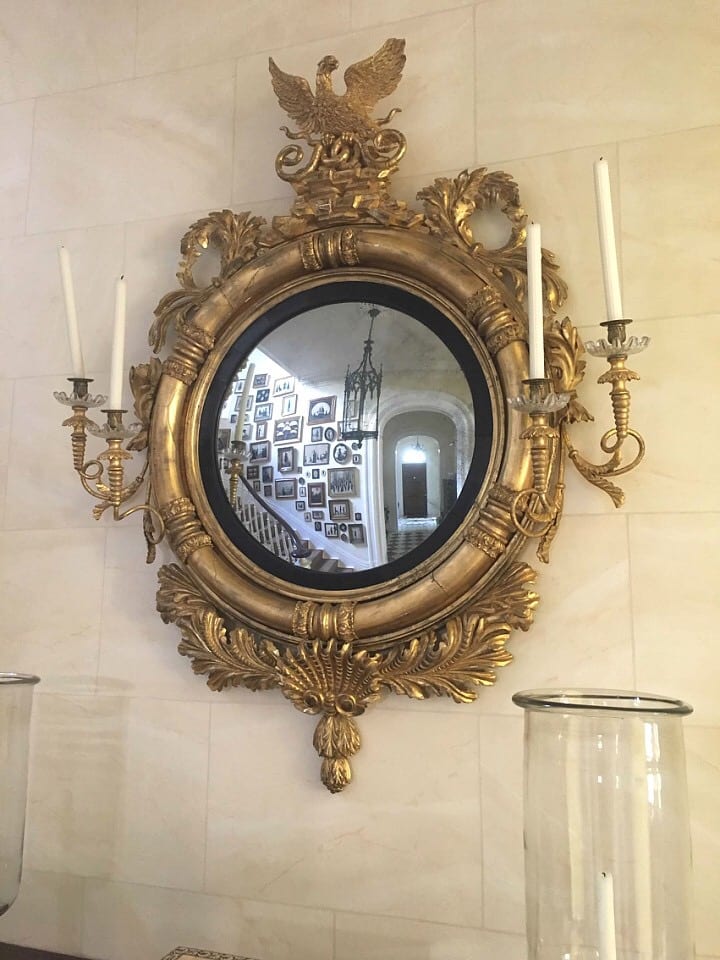
Silhouettes: 18th Century Snapshots
By Luzanne Otte
One sloping cut made forehead, olfactory organ, and chin,
A nick produced a mouth and made him grin
~ Jonathan Swift 1720
Definition
Silhouette (-ö-et'), n. [from Ètienne de Silhouette, French Government minister of Finance 1759]:
- An outline cartoon, especially a profile portrait, filled in with a solid color: silhouettes are ordinarily cutting from black paper and fixed on a light background
- Whatever dark shape or outline seen against a light background
- Techniques: Motorcar; painted free-hand using blackness Bharat ink on card, paper, plaster, or contrary glass; or cutting newspaper freehand
- Peak Popularity: 1780-1860
- Turn down: Began with the daguerreotype (1839) and cemented past the commercial production of cameras (1888).
- Modernly: Nostalgia and capturing the amuse of a bygone era have led to several resurgences of the parlor novelty, just remains classified as a lost art.
Development of a Shadowy Art
In pinpointing the origins of silhouette likenesses, also known as shade portraits or profile likenesses, art historians trace dorsum to prehistoric cave drawings, Egyptian hieroglyphics, Grecian vessels, and the Chinese paper cutwork of Antiquity. In an 1806 letter to the painter Philipp Otto Runge, Johann Wolfgang von Goethe noted the relationship between blackness
figured Grecian vessels and the silhouettes of his contemporaries. "I similar to experience that by silhouettes ii irrevocably sundered ages are fatigued together." While the function of the art in Antiquity and the Modern Catamenia varied, both forms reduced three-dimensional figures to simple contours emboldened by the interplay of light/dark and contrast of positive/negative space.
Prior to the advent of photography, silhouette likenesses offered an affordable and efficient alternative for those who could non afford a formal portrait. Profilists or silhouettists captured a subject'south likeness with physiognomic accuracy through a machine to trace the shadow bandage by a profile and then cut the outline, painting, drawing, cutwork, or a combination of each. Modernly, we tend to associate the term silhouette virtually exclusively with a hand-cut blackness bust set upon white paper. Notwithstanding, the term silhouette is more accurately understood as describing the general form of portraiture.
By the turn of the xixth century, the advent of photographic portraits led to the decline of silhouettes as a pop art form. While silhouette portraiture was considered passé to a majority of the population, a minority continued to support the art for diverse reasons. The primary reason asserted is that photographs capture a dynamic range of expressions, whereas the linear nature of an individual'south profile captured in black and white transcends temporal limitations. In other words, its bold simplicity is captivating.
Etymology of "Silhouette"
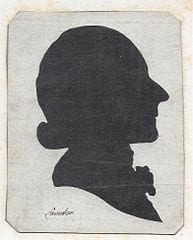
Johann Casper Lavater cocky-portrait using a physogniotrace (1787)
The get-go profile likeness in the historical record is a non-extant rendering of Monarchs William and Mary past Elizabeth Rhijberg in 1699, only the novelty'due south heyday would not embark until the 1770s. Information technology was so that Swiss philosopher-preacher-scientist, Johann Casper Lavater, catapulted contour likenesses into the international consciousness with bestseller, Essays on Physiognomy; For the Promotion of the Knowledge and the Love of Mankind (1774).
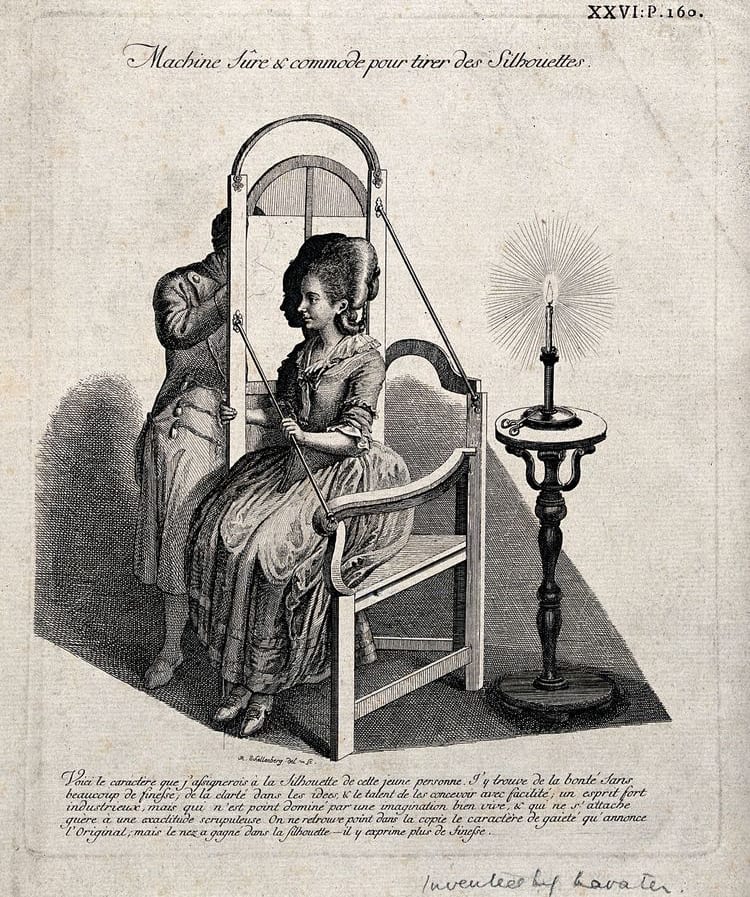
Sketch of Gilles-Louis Chrétien'due south physiognotrace past Johann Rudolph Schellenberg
Physiognomy explores the relationship betwixt facial features and personality traits. A machine called the physiognotrace cast a shadow on the subject's profile and a machinist traced its outline. "To be a physiognomist, the study of silhouettes is most essential; it is by silhouettes, the physiognomist volition exert and improve his tact; if he comprehends that linguistic communication, he will possess an agreement of the countenance of human being, he will read in information technology, equally in an open book." While the tenets of this pseudo-science were never fully embraced by the academy, Lavater's publications had the unintended effect of introducing profile likenesses every bit an inexpensive and instantaneously generated culling to the traditional painted portrait.
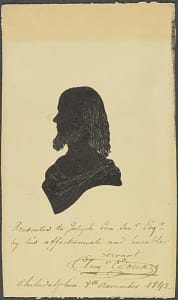
Auguste Edouart hand cut self-portrait (1843) – Source
Auguste Edouart emigrated from France to England post-obit the Napoleonic Wars and focused on hair work before identifying a need in the art marketplace for full-length likenesses cut freehand rather than by machine. Edouart constitute the likenesses produced past machine to be inanimate and contemptible to his refined sensibilities. The long-suffering Edouart sought to establish a reputation as a freehand virtuoso and distinguish himself as an artist among machinists. He addressed these topics, among other grievances and vexations, in A Treatise on Silhouette Likenesses (1835).
"Why does such prejudice exist against black shades, which I phone call Silhouette Likenesses? Persons who accept an opportunity of judging and comparing my works, which have been executed by the hands, with those executed past mechanical procedure, cannot help making a comparison of the prices, even while they give me the preference for the execution of the work" (pp. 97-98).
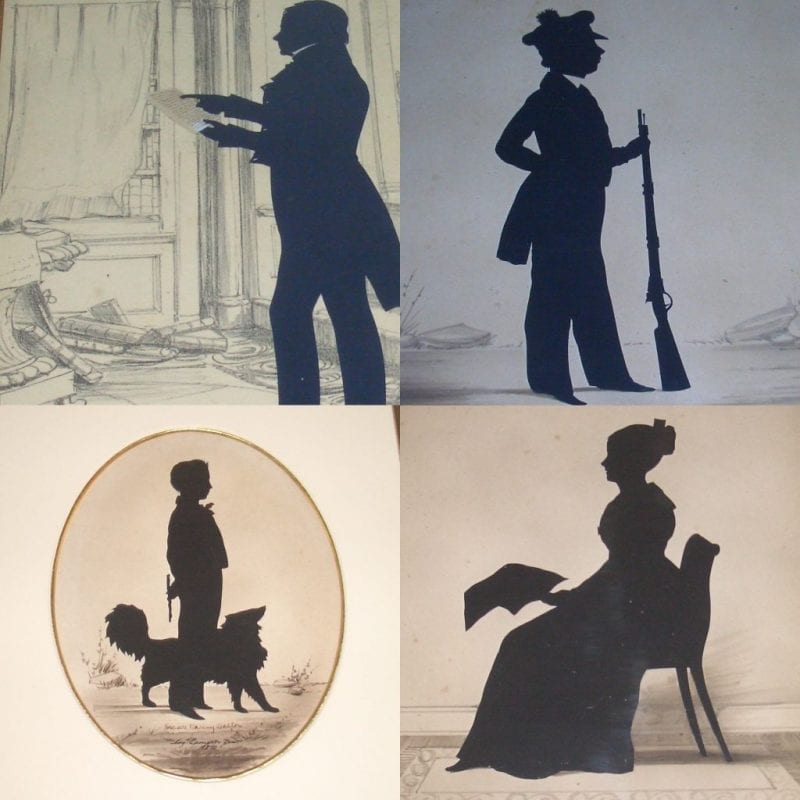
Four silhouettes of many past Edouart in the Altschul collection. In improver to expanding profiles to full-length, a distinguishing trademark of his piece of work is the ubiquitous white collar on male subjects. Emerging artists sketched 18 backgrounds (or substrate) which were reproduced en masse. Layering two pieces of newspaper, Edouart brandished a pair of embroidery scissors and cut the subject'due south likeness in an average of 2 minutes. I was affixed to the substrate and embellished with subtle detail work, and the other retained for his personal annal.
Edouart begins by explaining the origin of "silhouette" likenesses. The eponymous term refers to a profilist and French Minister of Finance, Ètienne de Silhouette, who served during the reign of King Louis XV. Silhouette'due south parsimonious policies led to his name beingness associated with all things miserly. It was during his tenure that profile likenesses produced past shadows became fashionable in France. Artists derisively referred to the cheap profile likenesses equally portraits a la Silhouette. Past retaining the French name in the English-speaking world, Edouart infused "the poor man'due south portrait" with a certain je ne sais quoi and distinguished his handmade likenesses from crude machine productions.
A more accurate title for the Treatise might exist, The Role of Idiosyncratic Trait Definitions in Cocky-Serving Assessments of Ability. Prejudice notwithstanding, the disquisition elevated the full general prestige of the art form and firmly established Edouart every bit the preeminent silhouettist of the Victorian era.
Interview with Patricia Altschul most her Silhouette Collection
Luzanne: Do y'all call up your first exposure to the globe of silhouettes?
Patricia: My Father was a diplomat and Medical Inspector to the Far East under President Franklin Roosevelt. The cute objects he gifted my Mother were formative in my development equally a collector. Growing upward, we had a few mannerly silhouettes in the firm and I expanded the collection with Arthur [Altschul] to include every incarnation of the art form.
Luzanne: No offense but silhouettes seem incongruous to the legendary museum quality art drove of Mr. Altschul.
Patricia: Arthur taught me a great deal virtually the fine art of collecting. We were drawn to different types of fine art to be sure, but one of our favorite pastimes was scouring antiquarian stores, flea markets, and galleries throughout the world for new art and antique acquisitions. A well-rounded drove includes the high and the low.
Luzanne: What would y'all say to those who acquaintance collecting with a hobby reserved to the One Per centum?
Patricia: Collecting is for everyone. Let me add that collecting doesn't equate to hoarding – although the antique Red china pug figurines that threaten to overtake the first floor may suggest otherwise. There are myriad motivations for each of my collections – some evoke pride in owning exquisite objects (compounded when acquired for a bargain), others bolster a connectedness to my personal history, and others are but fun. Whatever inspires me, I collect and I count anything as a drove from xviiith century French clocks to animated costly toys like the iguana who sings Feliz Navidad.
Luzanne: Amid your vast antique silhouette collection, practice you have a favorite?
Patricia: I gravitate to the exquisite detail in British silhouettes, equally their American counterpart tend to be more than rudimentary. My artful favorite is the conversation piece by Francis Torond. My historical favorite is the profile of George Washington past Samuel Folwell.
Luzanne: As far as I tin can tell, you accept at to the lowest degree one work by every major silhouettist. Are at that place any gaps in your collection that you'd like to make full?
Patricia: [Looking at the hundred or and then silhouettes in the stair hall] Even if I had a theoretical gap to fill up, I would need a concrete gap in which to fill it.
Luzanne: Touché.
Significant Silhouettes in Patricia's Collection
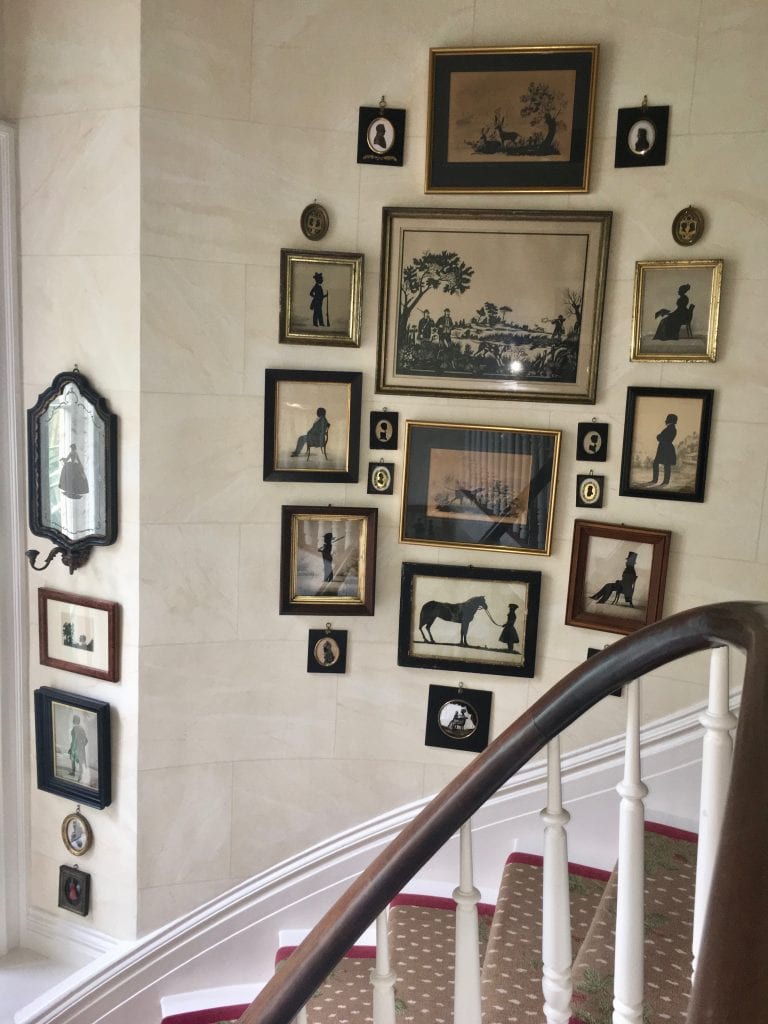
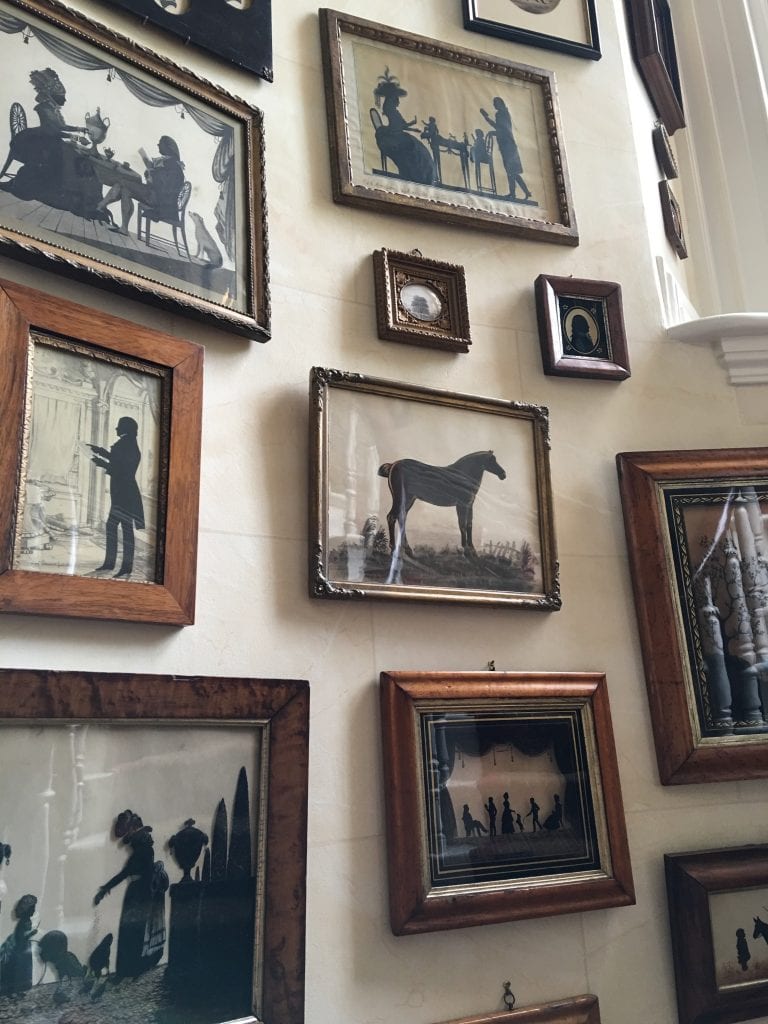
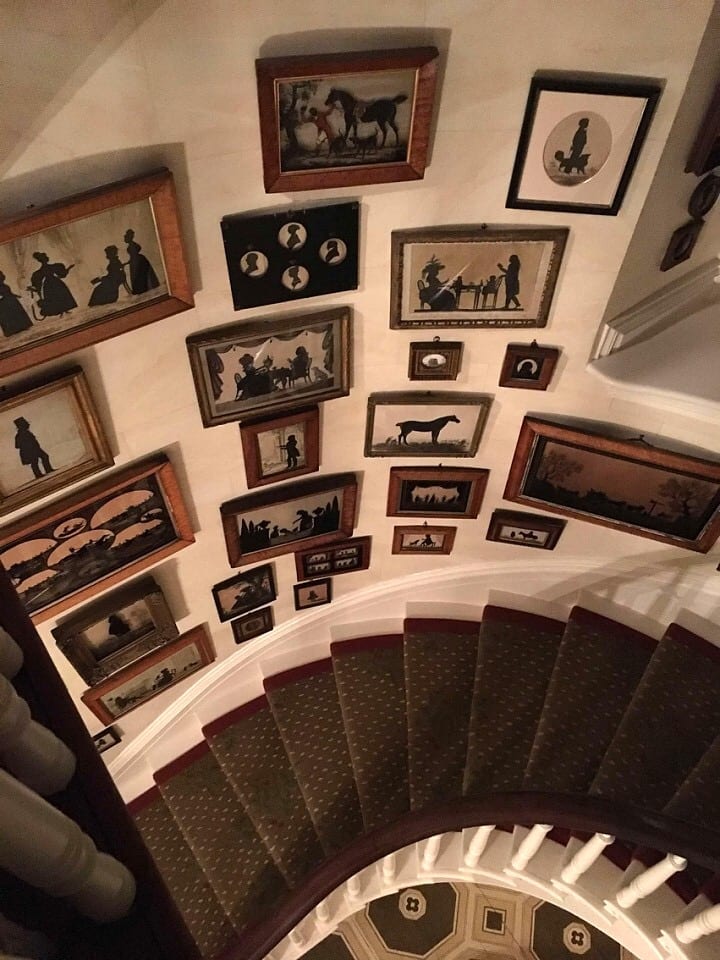
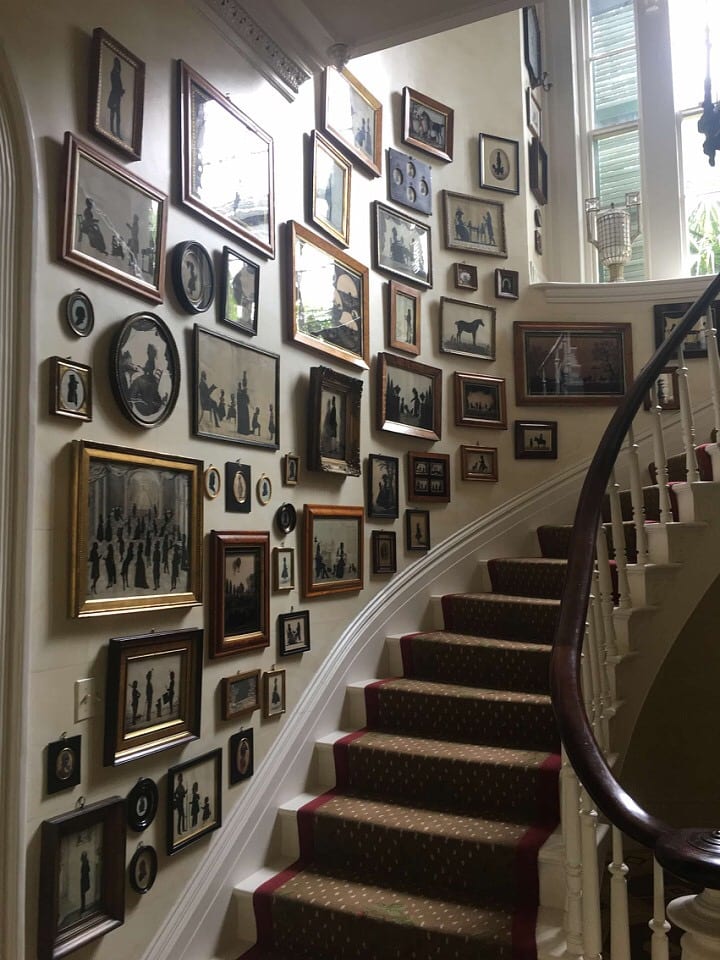
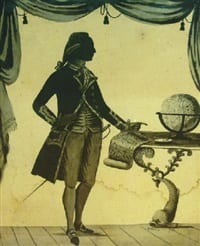
William Wellings
1773-1796
British
Description (for in a higher place): Captain Peyton, his powdered hair en queue, wearing Naval uniform, stock, cravat buckle shoes with the customary world and compass (1782). Size: 9.8" ten 7.8"; Materials and Technique: Laid paper painted in Bharat ink with details added in grey and brown.

Francis Torond
1743-1812
French émigré to Great britain
Description (for above in oval frame): A silhouette conversation slice of James and Florence Lowther seated at a tabular array, engaged in a game of cards: he, facing right wearing a frock coat; she, facing left wearing dress and fur stole, her hair in a banging chignon, the table dressed with candlesticks, snuffer and tray (1784). It's valuable for a diversity of reasons: signed and dated by a primary silhouettist who rarely comes on the market place, named subjects, original frame. Size: eleven.ane" round; Materials and Technique: Painted on laid paper with original gilded gesso frame with beaded border.

Samuel Falwell
1765-1813
American
Clarification (for higher up): Bosom profile of George Washingon facing right, eyelashes delineated, wearing a buttoned coat, frilled cravat, hair tied with a ribbon. This is the just silhouette of Washington painted from life. Legend has information technology that Washington was an unsuspecting subject while attending a church service. Folwell sought to capture a sacred moment in the new land's history past attempting a visual argument on the condition of its leader (1791). Size: 3.25″ 10 2.5"; Materials and Technique: Laid newspaper painted in India ink with details added in white. Early oak and golden frame on eglomisè drinking glass.
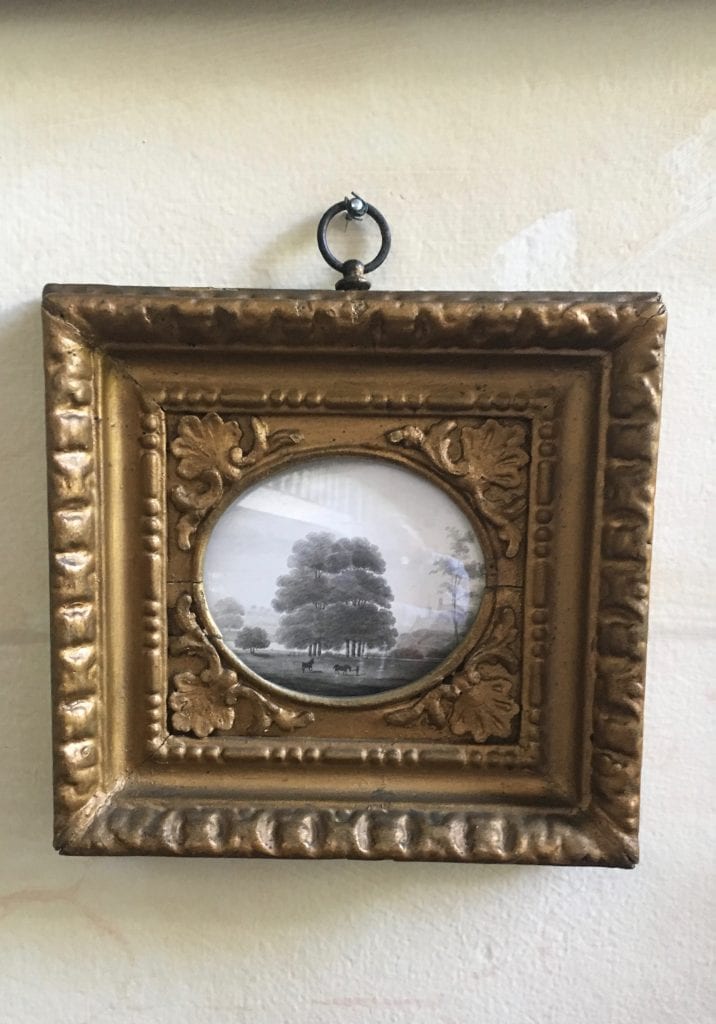
John M. Field
1771-1841
British
Description (for to a higher place): Part of the Lawn and Go along, Cardiff Castle. Exhibited at the Royal University. Despite Field producing a number of landscape at his shop on the Strand with silhouette master, John Miers, the miniatures are exceedingly rare in the market place (1825). Size: 2.5" x 2.5"; Materials and Technique: A miniature painted on plaster in monochrome and penciled with gold. Rectangular gilded composition frame.
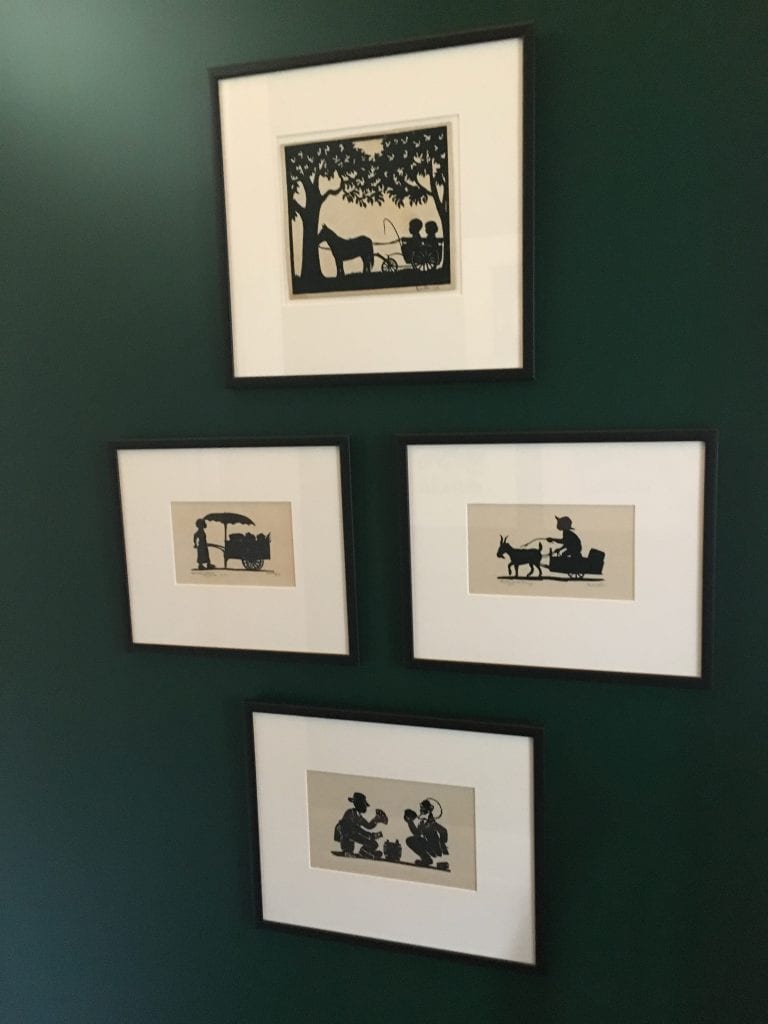
Carew Rice
1899-1971
American
Charlestonian, Carew Rice, thought of his work every bit a honey letter of the alphabet to the marginalized members of the Low Country. Although his silhouettes were inspired past principles, Rice was besides a pragmatist who successfully tapped into the commercial market for Old Southward nostalgia: picturesque landscapes, atomic number 26 gates, wildfowl.
Suggested Resources for Continuing Education!
- Kathryn F. Flocken's book, Silhouettes: Rediscovering the Lost Art, is available on her website which also provides resources on all-things silhouette.
- A 250 year historical annal of British silhouettes
- Charleston is home to honor-winning silhouette creative person and Carew's grandson, Dirt Rice.
- The documentary, Silhouette Secrets , is bachelor for free on Amazon Prime number.
- The Smithsonian National Portrait Gallery in Washington D.C. has an exhibition exploring the historical and contemporary interpretations of the silhouette in America from now through March x, 2019, " Black Out: Silhouettes Then and Now ".
Wow, what a rich history, I am now inspired to aggrandize my small silhouette drove! Please check back next Midweek for Luzanne'due south third invitee post. Click hither to read Luzanne's detailed account of her experience as Patricia's houseguest, and you won't want to miss her guest mail "A Day in the Life of Southern Charm's Patricia Altschul" featured via Town & Country. You might also relish my past features:
- PATRICIA ALTSCHUL'S TIPS FOR CREATING A TIMELESS HOME
- 10 OF PATRICIA ALTSCHUL'Due south FAVORITE THINGS
- PATRICIA ALTSCHUL'Due south Domicile IN CHARLESTON HOME + DESIGN
- MARIO BUATTA AND PATRICIA ALTSCHUL EXUDE SOUTHERN Charm IN CHARLESTON
- SOUTHERN CHARM WITH PATRICIA ALTSCHUL
- PATRICIA ALTSCHUL'S DERBY PARTY IS FULL OF SOUTHERN Amuse
- PATRICIA ALTSCHUL'South MANHATTAN MAISONETTE: DESIGNED BY MARIO BUATTA
Thank y'all Luzanne and Patricia!

Source: https://www.theglampad.com/2018/07/the-history-of-silhouettes-and-an-interview-with-patricia-altschul-about-her-collection.html
0 Response to "Indian Artist in Austin Museum Who Creates Art With Paper Silloette"
إرسال تعليق